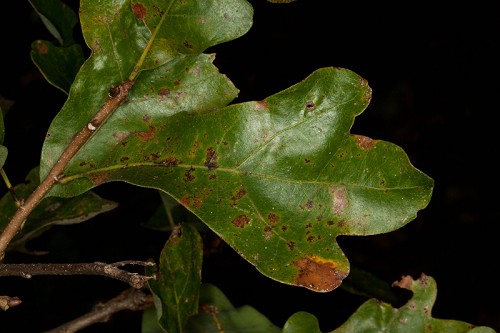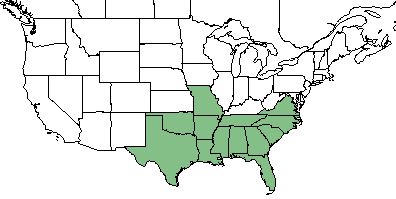Quercus margarettae
Common name: sand post oak [1]
| Quercus margarettae | |
|---|---|

| |
| Photo by John Gwaltney hosted at Southeastern Flora.com | |
| Scientific classification | |
| Kingdom: | Plantae |
| Division: | Magnoliophyta - Flowering plants |
| Class: | Magnoliopsida - Dicots |
| Order: | Fagales |
| Family: | Fagaceae |
| Genus: | Quercus |
| Species: | Q. margarettae |
| Binomial name | |
| Quercus margarettae Ashe | |

| |
| Natural range of Quercus margarettae from USDA NRCS Plants Database. | |
Contents
Taxonomic Notes
Synonyms: Q. margaretta, orthographic variant; Q. margarettiae W.W. Ashe ex Small, orthographic variant; Q. stellata var. margaretta (W.W. Ashe ex Small) Sargent, orthographic variant]
Varieties: none
Description
Q. margarettae is a perennial shrub/tree of the Fagaceae family native to North America.[2]
Distribution
Q. margarettae is found in the southeastern corner of the United States from Texas to Virginia.[2]
Ecology
Habitat
Q. margarettae proliferates in sandhills, typically in slightly loamy or clayey soils, not usual in the deepest and most xeric sands.[1] Specimens have been collected from mixed woodland, longleaf pine-scrub oak, sandpine flatwoods with sandy soil, hardwood hammock, planted slash pine on sand ridge, longleaf pine wiregrass scrub oak ridge, hardwood stand, beach ridge, sand pine scrub, and loamy sand of xeric flatwoods.[3]
Q. maragarettae reduced its occurrence in response to soil disturbance by agriculture in South Carolina longleaf woodlands.[4] It has shown resistance to regrowth in reestablished longleaf woodlands that were disturbed by agriculture in South Carolina, making it a possible indicator species for remnant woodlands.[5]
Q. margarettae does not respond to soil disturbance by clearcutting and chopping in north Florida flatwoods forests.[6]
Quercus margarettae is frequent and abundant in the Panhandle Xeric Sandhills, North Florida Subxeric Sandhills, and Clayhill Longleaf Woodlands community types as described in Carr et al. (2010).[7]
Phenology
Q. margarettae has been observed to flower March through June.[8]
Seed dispersal
This species is thought to be dispersed by gravity.[9]
Fire ecology
Populations of Quercus margarettae have been known to persist through repeated annual burns.[10][11]
Conservation, cultivation, and restoration
Cultural use
Photo Gallery
References and notes
- ↑ 1.0 1.1 Weakley, A. S. (2015). Flora of the Southern and Mid-Atlantic States. Chapel Hill, NC, University of North Carolina Herbarium.
- ↑ 2.0 2.1 USDA Plant Database https://plants.usda.gov/core/profile?symbol=QUMA13
- ↑ URL: http://herbarium.bio.fsu.edu. Last accessed: June 2018. Collectors: R.K. Godfrey, Loran C. Anderson, Patricia Elliot, W.D. Reese, D.B. Ward, Sidney McDaniel, H.E. Grelen, George Cooley, Richard Eaton, James D. Ray Jr., H. Kurz, Richard Carter, Brenda Herring, Don Herring, Andre F. Clewell, S.W. Leonard, - Thompson, R.F> THorne, R.A.Davidson, Gwynn Ramsey, Richard Mitchell, J. Hardin, Wilson Baker, Angela Peid, K.M. Robertson, Kevin Oakes, Chris Cooksey, MacClendons, Mears, Wilder. States and counties: Florida (Leon, Walton, Okaloosa, Jackson, Liberty, Lafayette, Madison, Alachua, Gadsden, Wakulla, Escambia, Citrus, Marion, Suwannee, Santa Rosa, Bay, Dixe, Washington, Hernando, Duval, Calhoun) Georgia (Thomas, Brook)
- ↑ Brudvig, L.A. and E.I. Damchen. (2011). Land-use history, historical connectivity, and land management interact to determine longleaf pine woodland understory richness and composition. Ecography 34: 257-266.
- ↑ Brudvig, L.A., E Grman, C.W. Habeck, and J.A. Ledvina. (2013). Strong legacy of agricultural land use on soils and understory plant communities in longleaf pine woodlands. Forest Ecology and Management 310: 944-955.
- ↑ Moore, W.H., B.F. Swindel, and W.S. Terry. (1982). Vegetative Response to Clearcutting and Chopping in a North Florida Flatwoods Forest. Journal of Range Management 35(2):214-218.
- ↑ Carr, S.C., K.M. Robertson, and R.K. Peet. 2010. A vegetation classification of fire-dependent pinelands of Florida. Castanea 75:153-189.
- ↑ Nelson, G. PanFlora: Plant data for the eastern United States with emphasis on the Southeastern Coastal Plains, Florida, and the Florida Panhandle. www.gilnelson.com/PanFlora/ Accessed: 24 MAY 2018
- ↑ Kirkman, L. Katherine. Unpublished database of seed dispersal mode of plants found in Coastal Plain longleaf pine-grasslands of the Jones Ecological Research Center, Georgia.
- ↑ Robertson, K.M. Unpublished data collected from Pebble Hill Fire Plots, Pebble Hill Plantation, Thomasville, Georgia.
- ↑ Platt, W.J., R. Carter, G. Nelson, W. Baker, S. Hermann, J. Kane, L. Anderson, M. Smith, K. Robertson. 2021. Unpublished species list of Wade Tract old-growth longleaf pine savanna, Thomasville, Georgia.